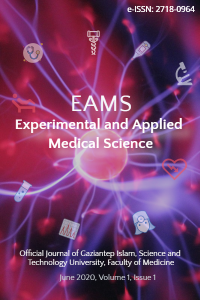Doksorubisin Kardiyotoksisitesinde Timokinonun Kan Parametreleri Üzerine Etkileri
Doksorubisin, Timokinon, Kardiyotoksisite
Effects of Thymoquinone on Blood Parameters in Doxorubicin Cardiotoxicity
Doxorubicin, Thymoquinone, Cardiotoxicity,
___
- 1. Raj S, Franco VI, Lipshultz SE. Anthracycline-induced cardiotoxicity: A review of pathophysiology, diagnosis, and treatment. Current Treatment Options in Cardiovascular Medicine. Current Science Inc. 2014; 16: 315-28. 2. Singal PK, Li T, Kumar D, Danelisen I, Iliskovic N. Adriamycin-induced heart failure: mechanism and modulation. Molecular and Cellular Biochemistry. 2000; 77–85. 3. Alam MF, Khan G, Safhi MM, Alshahrani S, Siddiqui R, Sivagurunathan Moni S, et al. Thymoquinone ameliorates doxorubicin-induced cardiotoxicity in swiss albino mice by modulating oxidative damage and cellular inflammation. Cardiology Research and Practice. 2018; 1–6. 4. Takemura G, Fujiwara H. Doxorubicin-Induced Cardiomyopathy. From the Cardiotoxic Mechanisms to Management. Progress in Cardiovascular Diseases. 2007; 49(5): 330–52. 5. Chatterjee K, Zhang J, Honbo N, Karliner JS. Doxorubicin Cardiomyopathy. Cardiology. 2010; 115(2):155–62. 6. Oz E, Erbaş D, Surucu SH, Duzgun E. Prevention of doxorubicin-induced cardiotoxicity by melatonin. Molecular and Cellular Biochemistry. 2006; 282: 31–7 7. Oz E, İlhan MN. Effects of melatonin in reducing the toxic effects of doxorubicin. Molecular and Cellular Biochemistry. 2006; 286: 11–5. 8. Bacak Güllü E. and Avci G. Thymoquinone: The Bioactive Component of Nigella Sativa. Kocatepe Veterinary Journal. 2013; 6(1): 51–61. 9. Uz E, Uz B, Selcoki Y, Bayrak R, Kaya A, et al. Cardioprotective Effects of Nigella sativa Oil on Cyclosporine A-Induced Cardiotoxicity in Rats. Basic Clin Pharmacol Toxicol. 2008; 103(6): 574–80. 10. Randhawa MA, Alghamdi MS, Maulik SK. The effect of thymoquinone, an active component of Nigella sativa, on isoproterenol induced myocardial injury. Pak. J. Pharm. Sci. 2013; 26(6): 1215-9. 11. Ojha S, Azimullah S, Mohanraj R, Sharma C, Yasin J, Arya DS, et al. Thymoquinone Protects against Myocardial Ischemic Injury by Mitigating Oxidative Stress and Inflammation. Evidence-Based Complementary and Alternative Medicine. 2015; 1–12. 12. Nagi MN, Al-Shabanah OA, Hafez MM, Sayed-Ahmed MM. Thymoquinone supplementation attenuates cyclophosphamide-induced cardiotoxicity in rats. Journal of Biochemical and Molecular Toxicology. 2011; 25(3): 135–42. 13. Seif AA. Nigella sativa attenuates myocardial ischemic reperfusion injury in rats. Journal of Physiology and Biochemistry. 2013; 69: 937–44. 14. Xiao J, Ke ZP, Shi Y, Zeng Q, Cao Z. The cardioprotective effect of thymoquinone on ischemia-reperfusion injury in isolated rat heart via regulation of apoptosis and autophagy. Journal of Cellular Biochemistry. 2018; 119: 7212–8. 15. Aydin MS, Kocarslan A, Kocarslan S, Kucuk A, Sezen H, Buyukfirat E, et al. Thymoquinone protects end organs from abdominal aorta ischemia / reperfusion injury in a rat model. Braz J Cardiovasc Surg. 2015; 30(1): 77–83. 16. Erel O. A novel automated direct measurement method for total antioxidant capacity using a new generation, more stable ABTS radical cation. Clinical Biochemistry. 2004; 37(4): 277–85. 17. Erel O. A new automated colorimetric method for measuring total oxidant status. Clinical Biochemistry. 2005; 38(12): 1103–11. 18. Yoshioka T, Kawada K, Shimada T, Mori M. Lipid peroxidation in maternal and cord blood and protective mechanism against activated-oxygen toxicity in the blood. American Journal of Obstetrics and Gynecology. 1979; 135(3): 372–6. 19. Nadif R, Bourgkard E, Dusch M, Bernadac P, Bertrand JP, Mur JM, et al. Relations between occupational exposure to coal mine dusts, erythrocyte catalase and Cu++Zn++ superoxide dismutase activities, and the severity of coal workers’ pneumoconiosis. Occupational and Environmental Medicine. 1998; 55(8): 533–40. 20. Atta MS, El-Far AH, Farrag FA, Abdel-Daim MM, Al Jaouni SK, Mousa SA. Thymoquinone attenuates cardiomyopathy in streptozotocin-treated diabetic rats. Oxidative Medicine and Cellular Longevity. 2018; 1-10. 21. Zheng J, Lee HCM, Bin Sattar MM, Huang Y, Bian JS. Cardioprotective effects of epigallocatechin-3-gallate against doxorubicin-induced cardiomyocyte injury. European Journal of Pharmacology. 2011; 652(1–3): 82–8. 22. Arslan SO, Gelir E, Armutcu F, Coskun O. The protective effect of thymoquinone on ethanol-induced acute gastric damage in the rat. Nutrition Research. 2005; 25:7 673–80. 23. Mansour MA. Protectıve effects of thymoquınone and desferrıoxamıne agaınst hepatotoxıcıty of carbon tetrachlorıbe ın mıce. Life Sciences. 2000; 66(26): 2583–91. 24. Yuluǧ E, Türedi S, Karagüzel E, Kutlu Ö, Menteşe A, Alver A. The short term effects of resveratrol on ischemia-reperfusion injury in rat testis. Journal of Pediatric Surgery. 2014; 49(3): 484–9.
- ISSN: 2757-847X
- Başlangıç: 2020
- Yayıncı: Gaziantep İslam Bilim ve Teknoloji Üniversitesi
Kronik Diyabetli Sıçan Kalbinin Histolojik Olarak İncelenmesi
Derya KARABULUT, Ali AKIN, Emin KAYMAK, Emel ÖZTÜRK, Meryem SAYAN
Doksorubisin Kardiyotoksisitesinde Timokinonun Kan Parametreleri Üzerine Etkileri
Deniz YILDIZ PEHLİVAN, Gülçin DURDAĞI
Antihistamin Levosetirizin Dihidroklorürün Sitogenetik Belirteçler Üzerindeki Etkisi
Hüsniye KUTLU, İbrahim Halil KENGER, Rima ÇELİK, Lale DÖNBAK, Ahmet KAYRALDIZ
Atatürk Barajı'nda, Ağır Metallerin Toksik Etkilerinin Araştırılması
Hikmet DİNÇ, Muhammet Yaşar DÖRTBUDAK
İbrahim Halil TÜRKBEYLER, Eyyüp Murat EFENDİOĞLU, Ahmet ÇİĞİLOĞLU, Azer ABİYEV, Zeynel Abidin ÖZTÜRK
